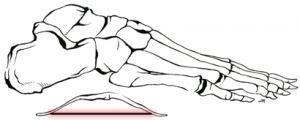Healthy Life: Plantar fasciitis, Calcaneal Spur and Spur at Achilles (853)
Healthy Life: Plantar fasciitis, Calcaneal Spur and Spur at Achilles
健康生活:蘇鎮邦 (Christopher So):
舒整物理治療師 (Manipulative Physiotherapist) 人類工程師 (Ergonomist)
Plantar fasciitis is similar to tendinitis. It is a very common soft tissue problem especially in ladies at menopause when hormonal changes soften the soft tissues. If these tissues receive undue pressure then they will degenerate and problems result. The most obvious symptom is unbearable pain on rising after long rest or sitting. Pain will only become bearable after walking or warming up for 10-20 minutes depending on the severity of the inflammation. Walking on grass or carpet is better than floor board or tiles.
The plantar fascia connects the metatarsals to the calcaneus or heel bone. This supports and sustains the arch in the foot (Diagram 1: a,b). Under pressure the plantar fascia is like the string on a bow. Prolonged pressure will cause thickening and inflammation of the fascia especially at the junction of the fascia to the bone. Eventually, it will cause calcification of the fascia at the bony junction and a bony spur will develop (Diagram 2: a,b). Clinically, there are more calcaneal spur cases than plantar fasciitis. It implies that plantar fasciitis is not the only or sole cause of a calcaneal spur. This means surgical removal of the spur does not necessary stop it from coming back. Professional advice and correction by wearing appropriate shoe, orthotics, and stretching exercises may be necessary. Over pronation or supination of the foot can also cause a calcaneal spur.

(Diagram 1,a)Foot arch-ery

(Diagram 1,b)

(Diagram 2a)

(Diagram 2b)
Tight calf muscles due to prolonged use of high heel shoes can cause spurs in the Achilles tendons and calcaneus. A number of my patients with such problems work in jobs that require long hours of standing. Many are over fifty years of age. They all show tightness in the Achilles tendons and plantar fascia. (Diagram 2 c).

Moreover, biomechanical investigations and clinical evidence demonstrate that high heel shoes cause Hallux Valgus or bunions, local foot arthritis, nerve entrapment between the metatarsals, tight calf muscles, pes cavus or high arch. It is advisable to avoid wearing high heels shoes. Occasional use of high heels at special events may be acceptable. If it is required for work, it is wise to change into soft -sole low heel shoes once you are within the office.
